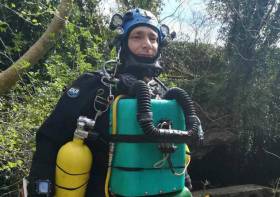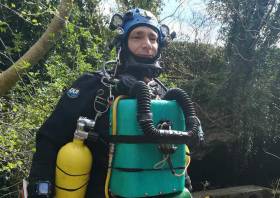Displaying items by tag: Jim Warny
#Diving - This year’s Dive Ireland International Expo opens tomorrow (Saturday 2 March) at the Great National Abbey Court Hotel in Nenagh.
Hosted by the Lough Derg Sub Aqua Club in association with the Irish Underwater Council, the two-day event will as ever feature a wide array of diving exhibitors, traders and speakers, as the Nenagh Guardian reports.
Star among them will be Clare-based cave diver Jim Warny, just months after his key role in the dramatic rescue of a youth football team from a flooded Thai cavern network.
Recently Warny was a guest at the Pendulum summit in Dublin where he downplayed his heroism, describing himself as “just a person with a specific skill”.
Irish Water Safety Honours Clare-Based Thai Cave Rescuer
#Diving - Irish Water Safety has honoured cave diver Jim Warny for his role in the rescue of the Thai football team earlier this year.
Warny also gave a presentation on the Tham Luang rescue operation at the IWS conference in Athlone’s Hodson Bay Hoetl yesterday (Saturday 20 October).
Twelve boys aged 11 to 17 and their 25-year-old assistant coach were rescued in early July after being trapped in the northern Thailand cave system for 18 days.
As previously noted on Afloat.ie, Ennis-based Warny was one of the Irish connections in the multinational rescue effort.
And he was one of the many expert divers who carefully guided the boys and their coach out of the 4km of twisting passages and flooded sections in total darkness.
IWS presented Warny with the Seiko ‘Just In Time’ Rescue Award for his contribution to that remarkable humanitarian achievement.
As the Irish Post reports, Warny is teaming with a film producer on a dramatisation of his experience in Thailand as well as cave diving closer to home.
#Diving - When Ennis-based cave diver Jim Warny arrived at the Tham Luang cave in northern Thailand earlier this month, he felt “within my comfort zone”.
That’s despite the unprecedented challenge that faced Warny and his fellow subterranean diving experts in mounting the “miracle” rescue of 12 boys and their football coach from the flooded cave system.
Speaking to The Irish Times, the Belgian national explained how it was only after switching from an organised military-style mission to a more decentralised strategy — with divers “operating outside procedures” — that the rescue team were able to navigate the sedated youngsters and their coach through the 4km of cave to safety.
Warny himself was responsible for helping the boys’ coach Ekapol Chantawong back into daylight, negotiating often tight spots in near total darkness with a stretcher and attached oxygen tank.
The Irish Times has much more on the story HERE.
Irish Connections In Remarkable Thai Cave Rescue
#Diving - Amid the jubilation surrounding the rescue of 12 boys and their football coach from a cave system in Thailand, The Irish Times notes an Irish connection to the story.
Belgian national Jim Warny, who lives and works in Ennis, was part of the international team of diving experts who mounted the daunting rescue operation at Tham Luang in northern Thailand over the past week, racing against time to save the soccer team before the cave flooded completely.
Warny was recruited for his expertise in cave diving — including his part in the recovery of friend Artur Kozlowski, who died during a dive near Gort in Co Galway in September 2011.
Kozlowski and Warny had together set a British-Irish record for a cave traverse the previous year.
Meanwhile, BreakingNews.ie highlights another Irish link to the Thai cave rescue, as a Limerick man donated crucial equipment to the effort.
The Cappamore man, who wished to maintain his privacy, volunteered some much-needed ‘last generation’ SCUBA tank regulators in response to a worldwide appeal for the specialist valves.


























